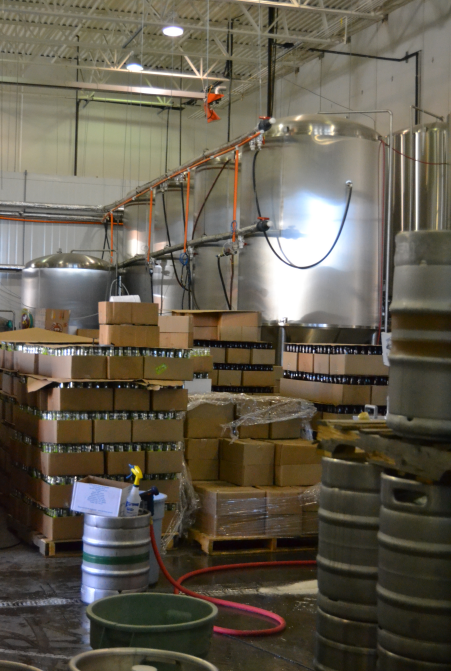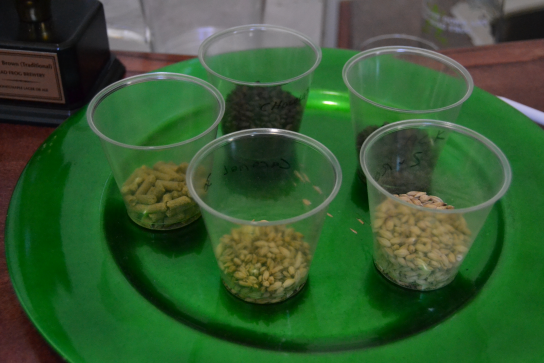By Karen Aney (The Cascade) – Email
Print Edition: October 3, 2012
In an effort to figure out exactly where beer comes from—and to celebrate local brewers—The Cascade sat down with Chris Landsman, vice president at Dead Frog Brewery in Aldergrove.
Tell me about how you landed this job.
Started here five years ago, actually got an email from one of my professors at Kwantlen … I started here, and there were around five employees. From there I went to marketing manager and then recently stepped into vice president.
So there’s been some fast growth in the company, then.
We’re available all the way to Ontario, up in the Yukon too. We’re expanding really fast, growing really fast. Craft beer is growing really fast right now, so we want to make sure that we’re at the ground level of it … as a result we obviously have to increase our capacity. We’re seeing a huge increase in sales in Alberta right now, so we’re spending a lot of time and energy making that go.
Can you explain what craft beer is?
Craft beer is essentially beer produced on a smaller, higher-quality level. Instead of producing beer in huge vats using alternative ingredients to cut costs, we use premium ingredients, traditional ingredients and small batches so we can make sure that the quality level is there. For craft beer, it stands for a higher level of quality: no preservatives, we don’t pasteurize … some of the big breweries have gotten into using syrup instead of actual grains—it’s cheaper—so craft breweries kind of stand for brewing beer in the traditional way. Grains, hops, water, yeast. If we do add anything, like the [Pepper Lime Lager] we have, we add black pepper and lime, but it’s all natural, real ingredients so it’s a little different. It’s all natural, premium.
What kinds of yeast do you use?
We use multiple kinds of yeast. There’s different kinds of yeast for different kinds of things. There’s lager yeast, and ale yeast, and they kind of have multiple different characteristics but ultimately produce a different end product. There’s Belgian yeast that we use for the wit [editor’s note: for witbier, meaning white beer]. Right now I think we have four or five yeasts in the brewery. There’s some breweries that will only use one or two kinds of yeasts, lager and ale usually, but we have more kind of specialty beers … so we need specialty yeasts for that.
Your Toasted Coconut beer is one that really interests me – can you tell me how it differs from the rest of your line?
The key things with a Belgian wit like that are the yeast – it’s a ground-level important piece of it; there are Belgian yeasts we use that kind of give that sweetness, the “bubblegum flavour,” is what they classify it as … then there’s spices [like] coriander and cloves. We actually toast coconut – we get all-natural shaved coconut and put it in after the fermentation so the coconut doesn’t ferment. It gives it that little bit of sweetness … we put the coconut into what’s called a hop sock, and that prevents it from getting into the beer, because if it gets into our beer then it gets into our filters.
How do you filter your beers? With a mesh grate? Or are they filtered at all?
It depends on the brew … for the toasted coconut it’s actually unfiltered. For cask products, we leave the yeast in, but we traditionally filter three times before it gets to the bottle. Yeast is an active ingredient in most products, the less active ingredients you have the better. We filter at three different levels because we have to have a shelf life of six months in all the government agencies, if it was our way we would probably produce beer to be consumed in a month. But when you’re shipping beer, that’s not a reality. It’s a balance between keeping the flavours in the beer, keeping the hop flavours—not stripping the hop flavours—so even at six months our beer is a solid, quality product.
So where is all the beer produced?
We make it all right here. There’s a distribution network set up for us to get our beer out there easily … Liquor connect, it’s called … it’s not cheap.
Can you explain the distribution process?
The way the liquor boards are set up is that … each province has its own governing agency with different rules and regulations … for us to sell beer in Alberta, we have to make sure we have someone living in Alberta and representing our product so we can’t just sell beer there and have all the profits come back to BC. They want to keep people employed in Alberta, keep profits in Alberta … we’re taxed less in Alberta, so we charge less and we still make more, so everybody wins.
How much of your business is in BC, then?
BC is the bulk of our sales because it is our backyard. We’re at the point where it comes off the line and we pretty much load it right on the truck. We added three new tanks this summer, now we’re trying to get the staff up to actually fill those tanks.
Where is Dead Frog headed – what’s your five year plan?
Our five year plan right now is to get distribution across Canada, get to the point where we have all of our provinces running smoothly and all of our staffing set up … and then eventually expand into the States, because especially on the west coast of the U.S. there’s a huge demand for craft beer right now, especially the kind of beer that we produce, which is really hop-forward. IPAs and our Pale ale would do really well.
Will you continue to produce new beers at the same time?
Yes. Craft beer is all about what’s new, at shows we always have people come up to us and ask what’s new. So we have our core line-up—our lager, our pepper lime, our pale ale and our nut ground ale—then we have a 650 ml lineup which is more geared towards craft beer enthusiasts or educated craft beer drinkers. So we have our new Fearless IPA coming out, which is really hop forward, bitter IPA that uses hops from New Zealand and from Yakama valley in Oregon, which is where most of the hops come from that west coast brewers use. It’s a really unique hop variety. The zythos and the galaxy actually give it a kind of tropical fruit aroma the cascade gives it a citrusy aroma. We also have our Stiff Stout, which is a higher alcohol stout – 6.5, and that’s what the IPA is as well.
Things like water can affect the flavour of beer dramatically. How do you control that?
We plate all of our beers and we analyze them on a micro-biological level, we send them out to labs on a regular basis. We plate them multiple times through the process … we take plates and take a microscope and run it through a boiler at extreme temperatures highs and lows and then we analyze them on a microbiological level to see what results. Brewing is incredibly scientific; a lot of brewers have science degrees.
Do your current brewers have a science background?
They’ve been to brew school. Tony Dewald is our head brewer right now, he started out in the ‘90s … he was one of the first people who brought IPAs up from Oregon, so he’s being doing it for 20 years now. And we actually have his brother-in-law who’s been in the industry for 10 years now, just got him on board, so they’re a great team. They’re pioneers in the industry and have a lot of credibility.
Let’s focus on the beer more. How long does it take to produce?
Once we have the recipe, for lager yeast they’re 21 days, for ale yeast they’re 14 days. After that, once you put the carbonation in, it’s still two weeks before you can taste it.
All beers start with grain. The grain determines the flavours and also the colour. Dark beer is dark grain, light beer is light grain. It doesn’t necessarily mean if the beer is darker that the beer is any more calories or higher alcohol or anything.
First it goes to the mash-tun. It stirs the grain around and the kernels break apart. The sugary sweetness from the grain goes into the water, all the rest of the stuff drops to the bottom.
Then we pump the water into the kettle and add the hops. The sugary sweetness from the grain and the flavour from the hops come together to make the flavour of the beer. That whole process takes about three hours for 3000 litres, so for a 9000 litre tank we do it three times and pump it into the tank. It goes from there to the fermentation vessels, where we add the yeast so the yeast can ferment. At that point, the yeast reacts with the sugary sweetness of the grain, and creates alcohol.
We take them out of the fermentation vessels and put them in … the bright tanks. We filter it twice in between, and at that point it’s essentially finished beer, it’s just not carbonated. Then we filter it one more time before bottling to make sure there was nothing that reacted badly to it in the bright tank. Then it gets bottled.




